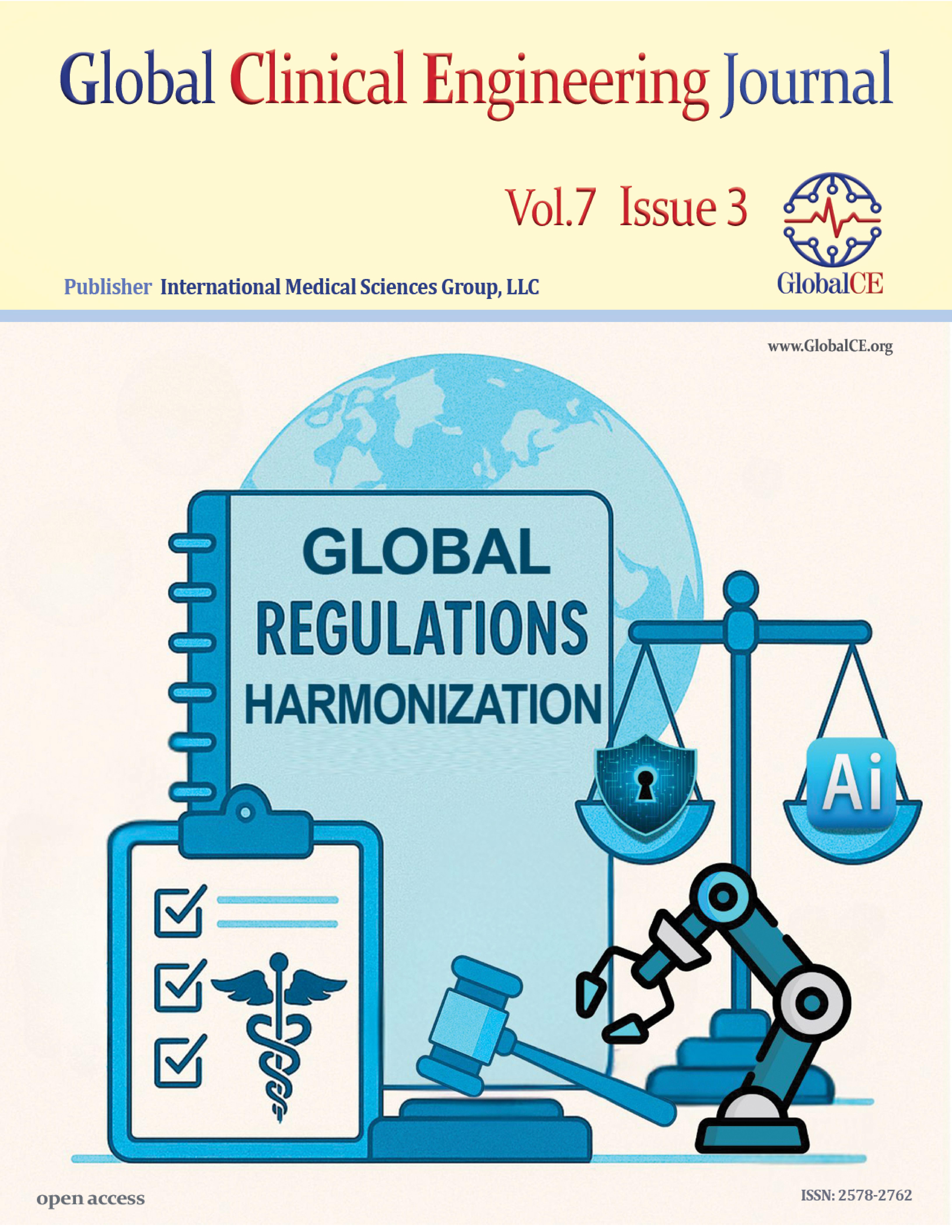Implementing Clinical Engineering Departments in a Small Hospital: A 2017–2021 Regulatory Compliance and Organizational Analysis
Main Article Content
Keywords
Clinical Engineering, Regulatory Compliance, Hospital Infrastructure, Medical Equipment Management, Patient Safety, Longitudinal Study, Statistical Analysis, Organizational Structure
Abstract
The integration of clinical engineering into healthcare systems is increasingly recognized as a key factor in improving regulatory compliance, equipment management, and patient safety. However, many hospitals in developing countries still lack formally established clinical engineering departments, leading to operational inefficiencies and safety risks. This longitudinal study evaluates the impact of implementing a clinical engineering department in a 10-bed secondary-level hospital between 2017 and 2021. Using a mixed-methods approach, regulatory compliance was assessed through two comprehensive audits conducted before and after the department’s implementation, based on 423 standards derived from national regulations. Regulatory compliance increased from 54.61% in 2017 to 78.72% in 2021. A two-sample Z-test for proportions confirmed that this improvement was statistically significant (Z = 7.44, p < 0.001) with a 95% confidence interval of 17.95% to 30.27%, suggesting that the change was unlikely because of random variation. Although the same set of standards was evaluated in both audits, the 4-year interval and lack of item-level tracking justified the use of this approximation. An organizational analysis revealed that while the department contributed significantly to equipment oversight, process standardization, and regulatory compliance, its participation in high-level strategic decision-making remained limited. The dual role in both operational and strategic tasks posed ongoing challenges in prioritization and impact. Semi-structured interviews with clinical, administrative, and technical staff supported the quantitative findings. A total of 93% of participants were aware of the department, 87% understood its functions, and 86% rated its performance as “Good” or “Very Good”. The majority also considered it essential or considerably necessary for hospital operations. Together, the quantitative and qualitative findings confirm that the creation of a clinical engineering department can significantly enhance hospital regulatory compliance, operational performance, and staff engagement with safety processes. These results provide a replicable model for healthcare institutions in similar contexts seeking to strengthen medical technology management and regulatory alignment.
Downloads
Abstract 339 | PDF Downloads 328
References
2. Fernández Avilés, L.E. Decodifying healthcare technology management (HTM) in Mexican private hospitals. IFMBE Proceedings. 2017.
3. Bello, M. COVID-19 highlights importance of biomedical engineers. Mexico Business News 2020. Available online: https://mexicobusiness.news/health/news/covid-19-highlights-importance-biomedical-engineers
4. World Health Organization. Human resources for medical devices, the role of biomedical engineers (WHO Medical Device Technical Series). Geneva: WHO; 2017. Available online: https://www.who.int/publications/i/item/9789241565479
5. David, Y. and Judd, T. Evidence-based impact by clinical engineers on global patient outcomes. Health Technol. 2020;10:517–35. https://doi.org/10.1007/s12553-019-00345-0
6. Ayala, R. and Orencio, E. Identification of health technology management departments in Mexico’s state health services. Glob Clin Eng J. 2019;2:17–21. https://doi.org/10.31354/globalce.v1i2.51
7. Cabrera Jaramillo, L., Rosas Pacheco, L.A., González Campos, E., et al. “Evaluación Normativa de Equipamiento e Infraestructura en hospitales en la ciudad de León, México: Estudio de caso,” presented at the IV Congreso Internacional de Ingeniería Clínica, Medellín, Col., 2019. Available online: https://www.researchgate.net/publication/339541172_Evaluacion_normativa_de_equipamiento_e_infraestructura_en_hospitales_en_la_ciudad_de_Leon_Mexico_Estudio_de_caso
8. Arab-Zozani, M., Imani, A., Doshmangir, L., et al. Assessment of medical equipment maintenance management: proposed checklist using Iranian experience. BioMed Eng OnLine. 2021;20(1):49. https://doi.org/10.1186/s12938-021-00885-5
9. Abdurabuh, A., Hamid, M.D., Che Hassan, C.R., et al. Evaluating the Impact of Hospital Accreditation on Patient Safety Culture in Saudi Arabia Healthcare Facilities. J Multidiscip Healthc. 2024;17:5021–5033. https://doi.org/10.2147/JMDH.S480496
10. Hussein, M., Pavlova, M., Ghalwash, M., et al. The impact of hospital accreditation on the quality of healthcare: a systematic literature review. BMC Health Serv Res. 2021;21(1):1057. https://doi.org/10.1186/s12913-021-07097-6






